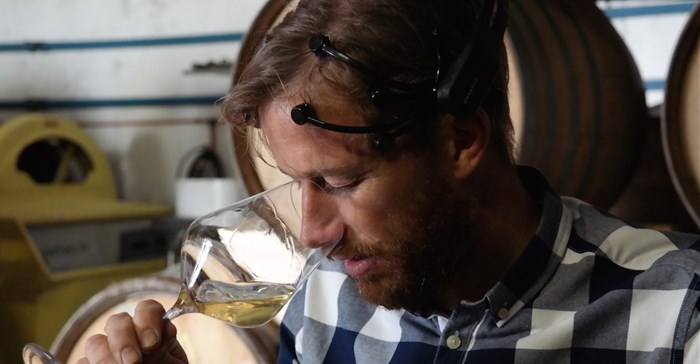Buried deep in our brains is a complex infrastructure of nerves known as the limbic system that keeps us alive on the most basic level. It tells us whether to feel fear, anger or joy, and controls our drives such as hunger, sex and taking care of our young.

Winemaker, Pieter Walser, put his instincts to the test
Tickling the tastebuds
Taste plugs directly into our limbic system. So it seems logical that making a wine would be based on the maker’s primal response to a taste. But generally this instinct is overruled by his or her knowledge of what it should taste like.
So Pieter Walser, a winemaker from the BLANKBottle label, partnered with a South African team of neuromarketers and neuroscientists to create the world’s first ever NeuroWine, a wine that was developed by taking the tools and technologies that are traditionally used in neuroscience and applying them to the art of the winemaking process.
Coloured by preconceptions
Walser admits that he sometimes struggles to create his blends due to his own preconceptions of what the wine should taste like, given his familiarity with the vineyards from which the grapes are sourced.
“I make a combination of 27 different varietals and I own no land, but I rent vineyards all over the Western Cape. I look at soil, climate and topography, and then I look at whatever grows best at each specific site.”
“The day I pick them, I taste the grapes and I decide more or less what the wine’s going to be like, but it then goes through different phases during the winemaking process so by the time I need to bottle – which is fairly soon - I can become confused,” Walser explains.
Using science to measure instinct
Neural Sense, a local neuromarketing consultancy, used neuroscience and biometric technologies to test 21 different white wine and 20 different red wine varietals from a number of vineyards across the country. They assessed Walser’s emotional and cognitive responses to each taste testing experience to create a red and a white wine.
Using an EEG (electroencephalograph), the team tapped into Walser’s brain activity as he tasted different wines.
Dr David Rosenstein, from Neural Sense, explains: “Back in our laboratory, we built a model of Pieter’s brain activity with Dr Lester Ryan John, and together with the other biometric data we were able to uncover his unconscious responses to the wine tasting experience.
“This model enabled us to determine what were the best performing aspects of the various wines he was tasting, and identify the top varietals that appealed to his unconscious, together with his subjective reporting, to form the NeuroWine blends as our ultimate goal.”
Seeing into the hearts and minds
“This neuromarketing approach has allowed my subconscious, and not my conscious, to do the talking,” says Walser.
Mark Drummond from Neural Sense adds, “Our job as neuroscientists and neuromarketers is to build an understanding of how people experience things and that could be the taste of a wine or it could even be the experience of looking at a wine label or bottle shape."
"Using neuromarketing techniques and technologies we are able to explore the subconscious and the underlying emotional drivers that influence decision making. This allows us to see into the hearts and minds of consumers, or winemakers in this case, giving us new insight into their experiences which can then be optimised."
NeuroWine will be launched in May 2016 and will be available through Woolworths as both a red and a white wine varietal.
































